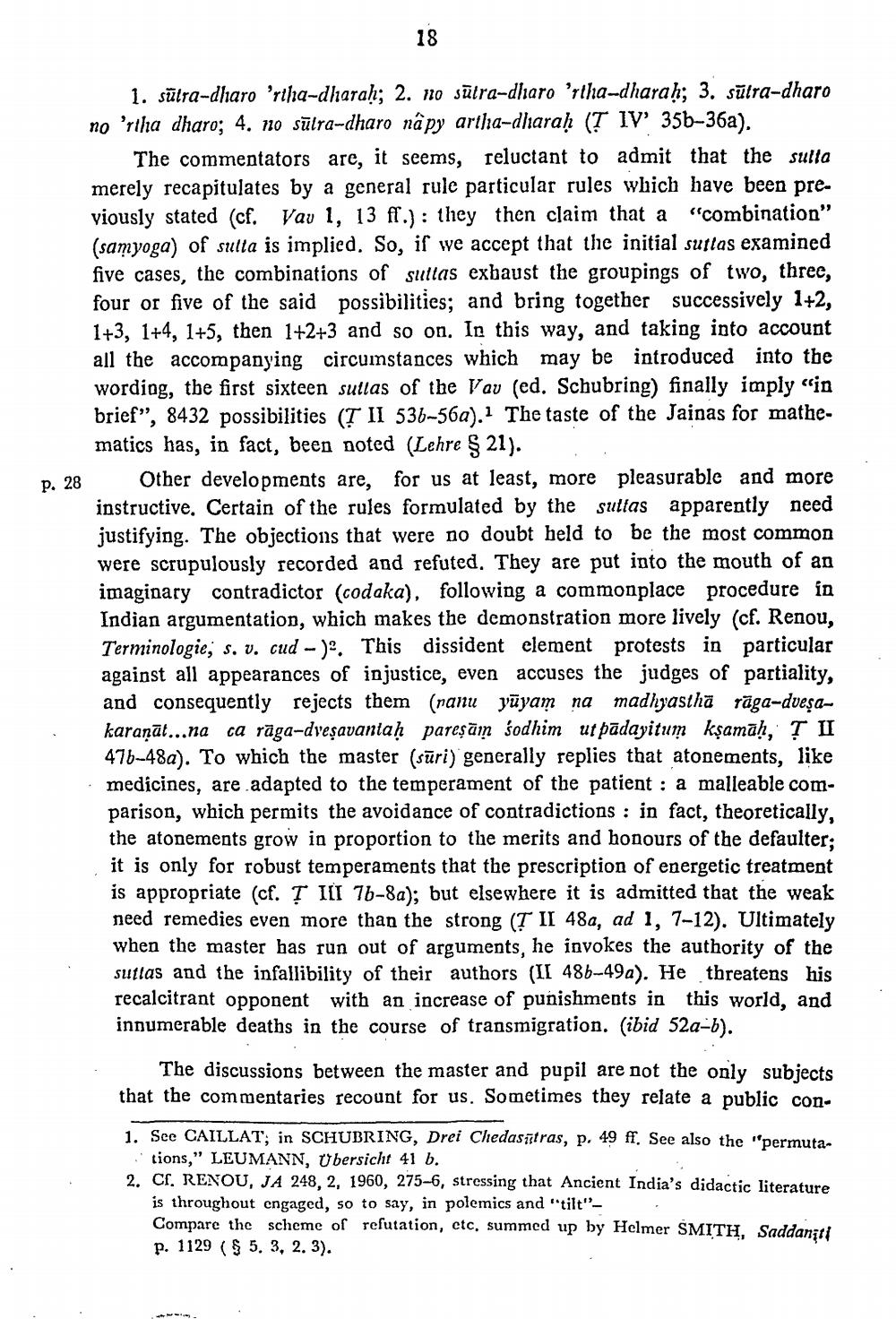________________
p. 28
18
1. sutra-dharo 'rtha-dharah; 2. no sutra-dharo 'rtha-dharaḥ; 3. sutra-dharo no 'rtha dharo; 4. no sutra-dharo nâpy artha-dharaḥ (T IV' 35b-36a).
The commentators are, it seems, reluctant to admit that the sulta merely recapitulates by a general rule particular rules which have been previously stated (cf. Vau 1, 13 ff.): they then claim that a "combination" (samyoga) of sulta is implied. So, if we accept that the initial suttas examined five cases, the combinations of sultas exhaust the groupings of two, three, four or five of the said possibilities; and bring together successively 1+2, 1+3, 1+4, 1+5, then 1+2+3 and so on. In this way, and taking into account all the accompanying circumstances which may be introduced into the wording, the first sixteen sutlas of the Vau (ed. Schubring) finally imply "in brief", 8432 possibilities (T II 536-56a).1 The taste of the Jainas for mathematics has, in fact, been noted (Lehre § 21).
Other developments are, for us at least, more pleasurable and more instructive. Certain of the rules formulated by the suttas apparently need justifying. The objections that were no doubt held to be the most common were scrupulously recorded and refuted. They are put into the mouth of an imaginary contradictor (codaka), following a commonplace procedure in Indian argumentation, which makes the demonstration more lively (cf. Renou, Terminologie, s. v. cud -)2. This dissident element protests in particular against all appearances of injustice, even accuses the judges of partiality, and consequently rejects them (ranu yuyam na madhyastha rāga-dveṣakaraṇāt...na ca raga-dveṣavantaḥ pareṣām sodhim ut padayitum kṣamāḥ, ŢII 47b-48a). To which the master (suri) generally replies that atonements, like medicines, are adapted to the temperament of the patient: a malleable comparison, which permits the avoidance of contradictions: in fact, theoretically, the atonements grow in proportion to the merits and honours of the defaulter; it is only for robust temperaments that the prescription of energetic treatment is appropriate (cf. T III 7b-8a); but elsewhere it is admitted that the weak need remedies even more than the strong (T II 48a, ad 1, 7-12). Ultimately when the master has run out of arguments, he invokes the authority of the suttas and the infallibility of their authors (II 48b-49a). He threatens his recalcitrant opponent with an increase of punishments in this world, and innumerable deaths in the course of transmigration. (ibid 52a-b).
The discussions between the master and pupil are not the only subjects that the commentaries recount for us. Sometimes they relate a public con
1. See CAILLAT; in SCHUBRING, Drei Chedasitras, p. 49 ff. See also the "permutations," LEUMANN, Übersicht 41 b.
2. Cf. RENOU, JA 248, 2, 1960, 275-6, stressing that Ancient India's didactic literature is throughout engaged, so to say, in polemics and "tilt"
Compare the scheme of refutation, etc, summed up by Helmer SMITH, Saddaniti p. 1129 (§ 5. 3, 2. 3).




